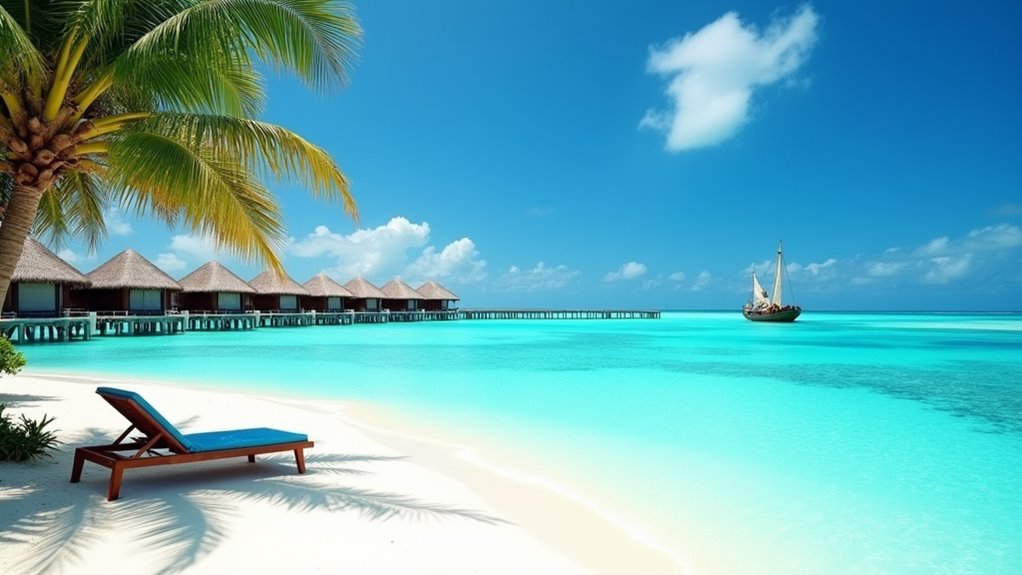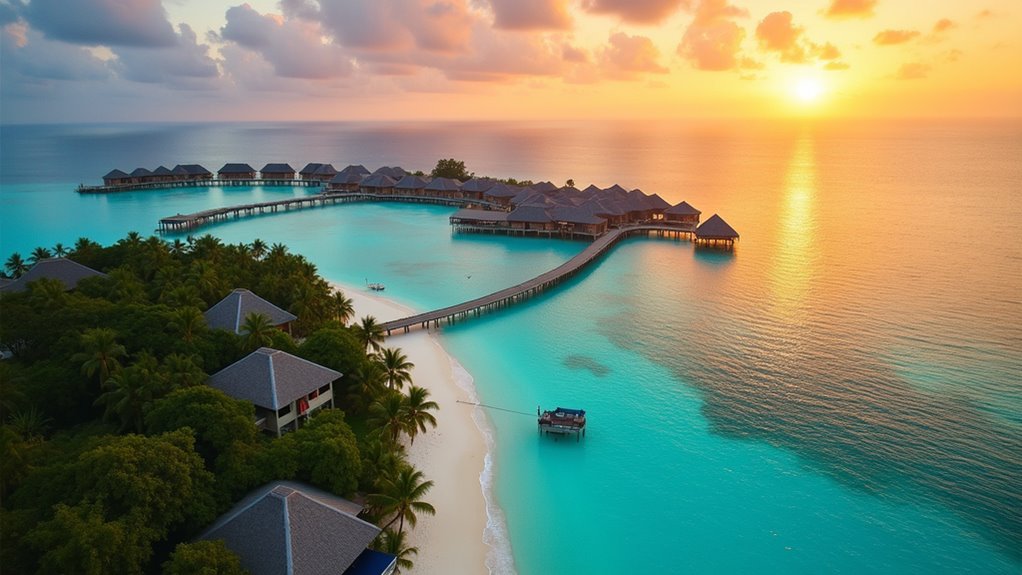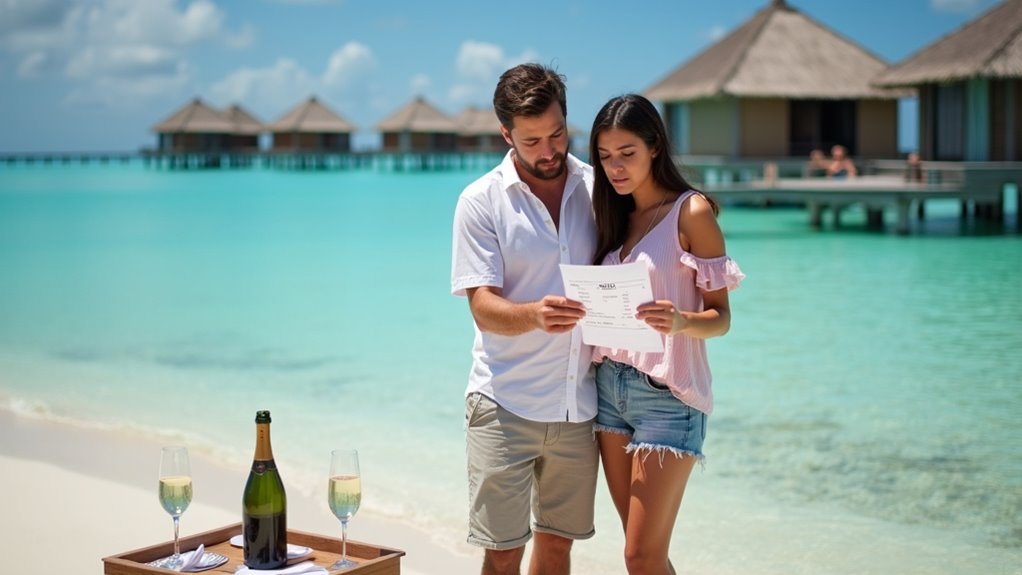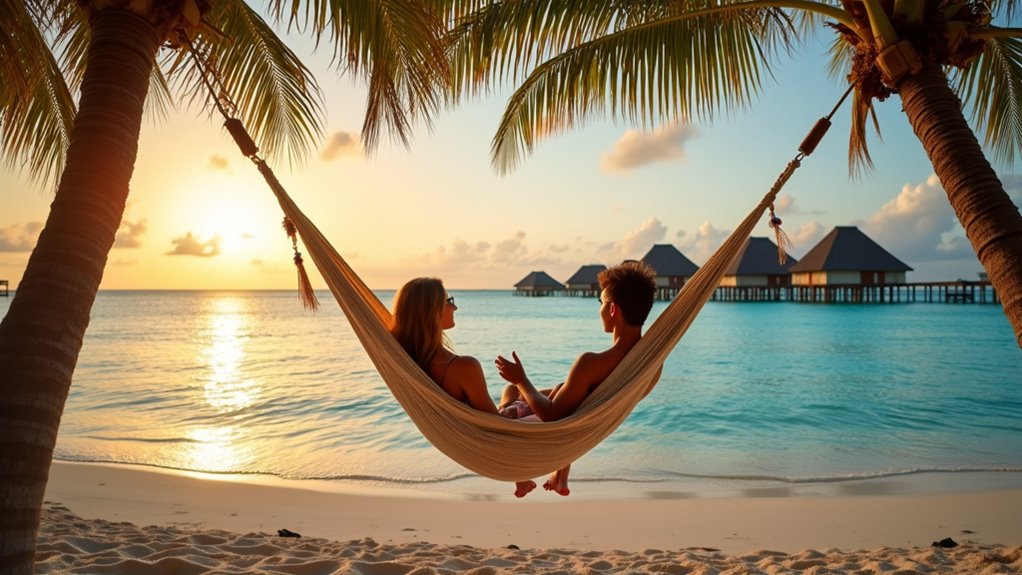Physical Address
304 North Cardinal St.
Dorchester Center, MA 02124
Physical Address
304 North Cardinal St.
Dorchester Center, MA 02124

Curious travelers can slash Maldives vacation costs by 50% with these insider strategies, but the pristine waters hide surprising challenges.
The Maldives’ high prices stem from geographic isolation, luxury positioning, and import dependency. You’ll face premium resort rates, extensive taxation (up to 25%), and costly transportation between islands. To visit affordably, travel during off-peak months (May-July, September, November) for 50% savings, book 6-12 months ahead, stay in local island guesthouses ($30/night), use public ferries ($2-5), and self-cater. These strategies can transform your Maldivian dream from prohibitively expensive to surprisingly achievable.

When considering a trip to the Maldives, you’ll quickly discover why it’s earned its reputation as a premium paradise. The destination caters primarily to affluent travelers, with 70% of travelers choosing luxury resorts in 2025.
You’re paying for exclusivity and unique experiences—private villas, personalized service, and fine dining that simply aren’t available elsewhere. This exclusivity drives prices up naturally, as the Maldives intentionally markets itself as a high-end destination. Seychelles is another popular luxury destination in the region that shares similar high costs.
Middle Eastern travelers particularly favor the Maldives for its luxury offerings, and they’re willing to pay premium rates for these exclusive experiences. The increased government taxes contribute significantly to the high costs visitors face. The tourism industry thrives on this luxury market, which forms the backbone of the Maldivian economy.
Understanding this luxury positioning helps explain the steep price tags you’ll encounter.
The luxury experience in the Maldives comes with practical explanations beyond marketing. This remote archipelago in the Indian Ocean faces unique challenges that directly impact your vacation costs.
Almost everything you’ll eat, drink, or use must be imported. With over 800,000 tonnes of fuel imported annually and limited local production, these islands depend heavily on external supply chains. The complex logistics of distributing goods across dispersed islands substantially increases prices. Alexandria and Hurghada offer different experiences compared to the Maldives, as they are not as geographically isolated.
Transportation between islands requires costly seaplanes or domestic flights, while maritime shipping remains essential but expensive. The infrastructure functions as meeting points between islands, inhabitants, and the sea. The limited space on islands restricts large-scale development that might otherwise reduce costs.
This geographic isolation creates a perfect storm for high prices: remote location + limited resources + expensive transportation = the premium you’ll pay for paradise.

Beyond the initial sticker shock of Maldivian resort prices, you’ll encounter a complex web of taxes and fees that considerably inflate your final vacation bill. International travelers now face steep departure taxes ranging from $50 for economy to $480 for private jets.
Your accommodation will likely add a 10% service charge plus GST, with guesthouses charging local taxes totaling 16-20%. These aren’t always included in advertised rates. VAT and service charges can add over 25% to your final bill.
Meal plans cost $50-$200 daily per person, with alcohol taxed heavily. Activities like excursions ($100-$300) and water sports carry separate fees. You should also watch out for dangerous animals in Lebanon, as they can pose a threat to your safety during your travels.
Don’t overlook transaction costs either—foreign card fees add 1-3% to purchases, while currency exchanges at resorts impose unfavorable rates and commissions. ATM withdrawals come with fixed and percentage-based charges.
Tucked away in the azure waters of the Indian Ocean, overwater bungalows represent one of the most expensive accommodation options you’ll encounter in the Maldives. Each villa costs between MVR 1.3-1.4 million to construct due to complex engineering requirements, marine-resistant materials, and sustainable design practices.
The hefty price tag comes from:
These factors, combined with seasonal pricing fluctuations and exclusive marketing strategies, explain why overwater accommodations often start at $1,000+ per night. The new DAMAC Properties development demonstrates this trend with their 120-villa luxury resort valued at AED 544 million spread across three private islands. Travel costs in Mauritius can provide useful insights on how to visit the Maldives for less.
For budget travelers, looking at beach villas or garden rooms offers substantial savings.

While most visitors anticipate high accommodation costs in the Maldives, many travelers are caught off guard by the steep food and beverage prices throughout the island nation. Food inflation rose by 5% in March 2025, reflecting the country’s heavy reliance on imports. Port Louis, the capital city of Mauritius, offers a more affordable alternative for travelers seeking a unique island experience. The island’s remote location creates significant supply chain challenges, with transportation costs reflected in your final bill. This is evident in the country’s substantial trade deficit of −242.70 USD million, highlighting the imbalance between imports and exports. Local restaurants offer better value than resort dining, where captive audience pricing is common.
Fresh produce is particularly expensive, with fruits like papayas and bananas seeing notable price increases. To manage costs, consider staying at guesthouses with kitchenettes, shopping at local markets, and focusing on locally sourced items. Dining at community cafés rather than resort restaurants can cut your food expenses by 30-50% without sacrificing the authentic Maldivian experience.
Timing your Maldives vacation can dramatically impact your budget, with prices fluctuating by as much as 50% between peak and off-peak seasons. January through April represents the premium dry season with minimal rain but maximum prices, while May-July and September offer significant savings with higher humidity and occasional storms. November is particularly attractive for travelers seeking value as it offers whale shark encounters along with competitive rates.
Strategic timing can cut your Maldives trip cost in half—paradise at a discount.
Book 6-12 months ahead for peak season (December-April) to secure your preferred resort. Consider shoulder months (April and October) for a perfect balance of good weather and lower rates. Look for last-minute deals during off-peak months when resorts drop prices to fill rooms. The Maldives is known for its high costs, which can make it challenging to visit for some travelers.
For the best value, target transition periods or be flexible with your travel dates – shifting your trip by just a week could save thousands while still delivering that picture-perfect Maldives experience.

Contrary to popular belief, experiencing the Maldives doesn’t require emptying your savings account on luxury resorts. Guesthouses on local islands like Maafushi, Fulidhoo, and Guraidhoo offer comfortable stays for around $30 per night—a fraction of resort prices. Seychelles is also an affordable destination, with a variety of budget-friendly options available.
Islands like Hulhumale feature budget-friendly options such as Pearl Hotel and Skai Lodge, while Rasdhoo’s Rasdu View Inn caters specifically to budget travelers. Most accommodations provide clean rooms, hot water, and Wi-Fi, with many offering traditional Maldivian meals. Hotels like Coconut Tree Hulhuvilla Beach are known for their affordable food options while maintaining a budget-friendly atmosphere.
For the best rates, book well in advance through platforms like Booking.com and consider traveling during off-season.
Many budget stays are conveniently located near ferry points and offer free or low-cost activities like snorkeling gear rental, letting you enjoy paradise without the premium price tag.
Beyond affordable accommodations, smart planning across all aspects of your trip can dramatically reduce your Maldives vacation costs. Timing and transportation choices make the biggest impact on your budget. Travel during off-peak seasons when prices drop markedly, and opt for public ferries ($2-5 per ride) instead of expensive speedboats or seaplanes when island hopping. Visiting the Nile destinations of Luxor or Alexandria can be an excellent addition to a Maldives trip.
Set a daily budget and stick to it religiously. Research extensively before your trip, connect with other budget travelers for insider tips, and always look for package deals that include transportation. Remember that the Maldives is a Muslim country where alcohol is only available at resort islands with special exemptions, not on public islands.
Despite its high costs, isn’t the Maldives still worth experiencing? By visiting during off-season, choosing local guesthouses over luxury resorts, planning meals carefully, and booking well in advance, you’ll dramatically cut expenses. Your paradise getaway doesn’t require emptying your savings account. With these practical strategies, you can enjoy those stunning turquoise waters and white sand beaches while keeping your budget intact.